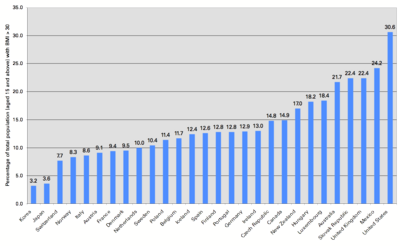"THE first steps on the long path preparing your child to win the battle against obesity are for him or her to engage in physical activity and eat healthy diets.
Over the past several decades, the prevalence of overweight children has increased dramatically in the United States, making it more likely that today's youth will be more susceptible to a number of serious, life-threatening illnesses earlier in life, including diabetes.
The increase in overweight children comes at a time when modern-day conveniences and activities--like fast food, the Internet and video games--have contributed significantly to sedentary lifestyles, a trend that is becoming more and more common among today's youth.
Estimates of the number of overweight and obese children and adolescents in the U.S. vary. Statistics from the U.S. Department of Health and Human Services indicate that 13 percent of children and 14 percent of adolescents are affected by obesity--triple the adolescent rate since 1980. A 1999 article in American Family Physician estimates that the numbers fall between 25 percent and 30 percent of children and adolescents. The increase extends across racial and social groups.
Now, childhood obesity experts like Dr. Shiriki Kumanyika, an associate dean and program director at the University of Pennsylvania School of Medicine, are trying to determine the cause for the sharp rise in overweight children. "We're trying to figure out how much of the problem is food intake and how much is the result of little to no physical activity," says Dr. Kumanyika. "The social trends affecting children are definitely in favor of overeating. The impact of eating portions that are twice as big as they were 10 years ago is tremendous."
Obesity is a risk factor for a variety of illnesses, including diabetes, and doctors are concerned that the condition accounts for the dramatic rise in childhood diabetes. Type 2 diabetes has reached epidemic proportions, particularly among African-American and Hispanic children living in poverty, according to the Children's Health Fund.
The good news is that parents and other caregivers can have a profound influence on children by serving as role models and helping to establish healthy eating habits. More often than not, bad eating habits and sedentary behaviors are established during childhood.
"Children need good role models when it comes to healthy living and healthy eating," says Greg McCollum, a personal trainer in Chicago's West Loop neighborhood. "If parents eat well routinely, their children will learn to eat well. One way parents can do this is to set up routines, like cooking dinner with their children to help explain the difference between good and bad foods."
The Institute of Medicine of the National Academies recommends the following tips to help parents raise children who eat nutritiously and are physically active:
Infancy: Breastfeed infants for the first four to six months of life. While the benefits are still being studied, doctors say breastfeeding helps, among other things, reduce the risk of obesity. "Infants have a preference for sweet and salty tastes and concern has been expressed that early introduction of sweetened beverages and high-fat/sweet foods to infants may be important contributors to childhood obesity," according to "Preventing Childhood Obesity: Health in the Balance," a report from the Institute of Medicine.
Toddlers and Young Children: Parental, child care and preschool guidelines can effectively encourage children to develop a healthy and varied diet without pressure. While young children seem naturally able to choose appropriate portion sizes and to eat only until they are no longer hungry, by the age of 5, research shows that they respond more to external cues and are more likely to eat everything they are presented, ignoring signals that they are full.
Older Children and Youth: Children begin to make their own choices at school and in other away-from-home settings. Parents can promote healthy food selections by making nutritious foods available at home and by encouraging family meals that children can help to prepare. Studies show that the more families eat together, the more likely older children and adolescents will consume fruits, vegetables, grains and calcium-rich foods.
Sweetened Beverages: Limit your children's intake of sweetened beverages and encourage him or her to drink nutrient-rich or low-calorie alternatives. Medical professionals are researching the association between childhood obesity and the consumption of sweetened beverages, like soft drinks and flavored drinks that do not contain 100 percent fruit juice.
These beverages do not provide important nutrients needed by growing children, but they do increase their calorie intake.
Physical Activity: Parents should be supportive of their children's athletic and other physical activity interests, and create opportunities for them to play outside and engage in recreational activities. In corporate physical activity into daily routines. For example, children can walk or bike with their parents in the neighborhood. Groups of parents can take turns walking children to and from school by forming so-called "walking school buses." In addition, work with the PTA at your child's school to improve or reinstate physical education programs.
Television Viewing and Recreational Screen Time: Limit television viewing and other recreational screen time, such as video or computer game playing, to fewer than two hours per day. A recent study found that youths who watched more than five hours of television a day were 4.6 times as likely to be obese as those watching no television or up to two hours daily.
Parents as Role Models: Serve as positive role models for children regarding eating and physical-activity behaviors. Discuss weight status with the child's health care professional and monitor age-and gender-specific body mass index. Parents are encouraged to work out with children, including such activities as practicing yoga and playing basketball.
In the end, Dr. Curtis Speed, a pediatrician with the Cook County Bureau of Health Services in Chicago, says that parents are the first defenders in the battle against childhood obesity. "Overeating is a learned behavior that is familial," Dr. Speed says. "Parents need to set examples. If your child is battling obesity, the solution is plain and simple: Help them to decrease their food intake and increase exercise. If they're not battling obesity, teach them to exercise and eat well early in life so that they can grow into healthy adults."
COPYRIGHT 2005 Johnson Publishing Co.
COPYRIGHT 2005 Gale Group




